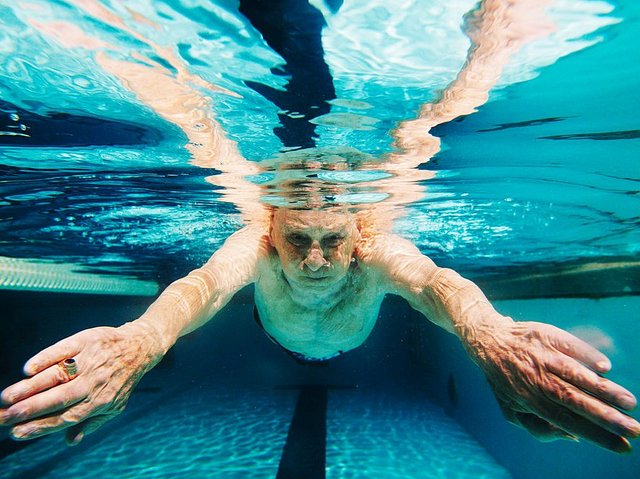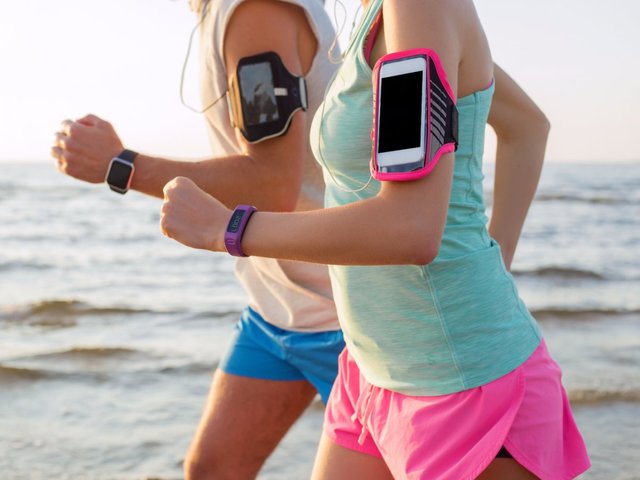11 ways one type of exercise is the closest thing to a miracle drug we have
Want an all-natural way to lift your mood, improve your memory, and protect your brain against the decline that comes with aging?
Get moving.
Exercises that get your heart pumping and sweat flowing — known as aerobic exercise, or "cardio" — have significant and beneficial effects on the brain and body, according to a wealth of recent research, including a new study published this fall.
"Aerobic exercise is key for your head, just as it is for your heart," according to an article in a Harvard Medical School blog. Here are some of the ways cardio is such a boon for our bodies.
Cardio tones your muscles.

It was initially believed that when it comes to building muscle, cardio paled in comparison to exercises like resistance training, which are specifically designed to help you gain strength. But a recent review of 14 studies published in the journal Exercise and Sport Sciences Reviews found that on average, men who did 45 minutes of moderate to intense cardio 4 days a week saw a 5%-6% increase in leg muscle size.
“Aerobic exercise, if done properly, can lead to as much muscle growth as you’d expect with resistance exercise,” Ball State University exercise scientist Matthew Harber, who authored the study, told Men's Fitness.
It also raises your heart rate, improving heart and lung health.

Aerobic workouts, especially swimming, train your body to use oxygen more efficiently, a practice that gradually reduces your resting heart rate and your breathing rate — two important indicators of cardiovascular health.
A 2008 study compared blood pressure, cholesterol levels, and other heart health metrics across close to 46,000 walkers, runners, swimmers, and sedentary people. The researchers found that the regular swimmers and runners had the best metrics, followed closely by the walkers.
Aerobic workouts appear to have a positive impact on your gut.

A small study published in November suggests that cardio exercise changes the makeup of the microbes in our gut.
Those microbes play a role in inflammation levels, which can be an early warning sign of illness.
The researchers had study participants exercise 3-5 times per week for 6 weeks, and observed increases in their concentrations of butyrate, a type of fatty acid that helps keep our guts happy by tamping down on inflammation and producing energy.
"These are the first studies to show that exercise can have an effect on your gut independent of diet or other factors," Jeffrey Woods, a professor of kinesiology and community health at the University of Illinois who led the research, said in a statement.
Cardio may improve cholesterol levels, too.

A large recent review of research on how cardio affects cholesterol levels looked at 13 studies on the topic. It found that aerobic exercise was tied with reductions in LDL, which is also known as "bad" cholesterol because it can build up on the walls of your arteries and raise your risk of heart disease. Cardio exercise was also linked with increases in HDL, also known as "good" cholesterol because it mobilizes the cholesterol in your blood.
"Prolonged moderate-intensity aerobic exercise should be recommended as a starting point for those who have previously been sedentary or are new to exercise," the authors wrote.
Aerobic exercise helps prevent and manage diabetes by improving the way the body uses blood sugar.

Several studies have found that cardio exercise helps people both prevent Type 2 diabetes and manage its symptoms — mostly by improving the way the body uses blood sugar.
A large Chinese study found that even modest changes in aerobic exercise (20 minutes of mild or moderate activity, 10 minutes of strenuous activity, or just 5 minutes of very strenuous activity 1-2 times per day) cut participants' diabetes risk by close to half.
A single session of cardio has been found to increase insulin action and glucose tolerance for more than 24 hours; one week of it can improve whole-body insulin sensitivity
Cardio workouts may even improve the look and feel of your skin.

A study from researchers at McMaster University found that people over age 40 who engaged in regular cardio activity tended to have healthier skin than their sedentary peers. The overall composition of the regular exercisers' skin was more comparable to that of 20- and 30-year-olds.
It's not yet clear why our workouts appear to play a role in skin health, but the researchers found elevated levels of a substance critical to cell health called IL-15 in skin samples of participants after exercise. That finding that could shed light on why cardio seems to make our skin look better.
Aerobic exercise benefits your mind, too — it can lift your mood, for example.

Aerobic exercise "has a unique capacity to exhilarate and relax, to provide stimulation and calm, to counter depression and dissipate stress," according to an article in the Harvard Medical School blog "Mind and Mood."
The reason aerobic workouts lift our spirits seems related to their ability to reduce levels of natural stress hormones, such as adrenaline and cortisol, according to a recent study in the Journal of Physical Therapy Science. Activities like running and swimming also increase overall blood flow and provide our minds fresh energy and oxygen — another factor that could help us feel better.
Workouts may reduce the symptoms of depression.

In addition to boosting the moods of healthy people, aerobic exercise may have a uniquely powerful positive impact on people with depression.
In a pilot study, people with severe depression spent 30 minutes walking on treadmill for 10 consecutive days. The researchers found the activity was "sufficient to produce a clinically relevant and statistically significant reduction in depression."
Cardio appears to guard against some age-related decline like reduced brain connectivity.
As we age, the brain — like any other organ — begins to work less efficiently, so normal signs of decline begin to surface. Our memory might not be quite as sharp as it once was, for example.
But older people who develop Alzheimer's disease often first enter a stage known as mild cognitive impairment (MCI), which involves more serious problems with memory, language, thinking, and judgment.
A study published in May looked at adults with MCI between the ages of 60-88, and had participants walk for 30 minutes four days a week for 12 weeks. The results showed strengthened connectivity in a region of the brain where weakened connections have been linked with memory loss. That development, the researchers noted, "may possibly increase cognitive reserve," but more studies are needed.
Aerobic exercise may help protect against memory difficulties in people undergoing chemo as well.

In a July study, researchers examined hundreds of breast cancer survivors to see if activities like walking and swimming have an effect on "chemo brain," a commonly reported side effect of breast cancer treatment that involves memory loss and difficulties focusing.
They gave nearly 300 breast cancer survivors accelerometers to track their activity, and provided them with an iPad app that featured quizzes designed to measure their attention and memory. At the end of a week, people who'd done aerobic exercise every day were significantly less tired than those who did little to no exercise, and also performed better on the app's quizzes.
"The message for cancer patients and survivors is, get active!" Diane Ehlers, the lead author on the study and a professor of exercise psychology at the University of Illinois at Urbana Champaign, said in a statement.
Cardio may be tied to increases in the size of brain areas linked to memory, but more research is needed.

A study of older women with MCI found that aerobic exercise was tied to an increase in the size of the hippocampus, a brain area involved in learning and memory.
For the study, 86 women with MCI between 70 and 80 years old were randomly assigned to do one of three types of exercise twice a week for six months. Some did aerobic training (like walking and swimming), others focused on resistance training (like weight-lifting), or balance training.
Afterwards, only the women in the aerobic group were found to have significant increases in hippocampal volume, but more studies are needed to determine what effect this has on cognitive performance.